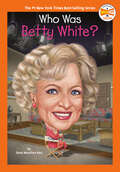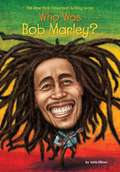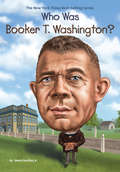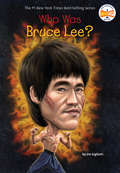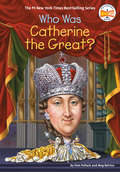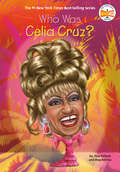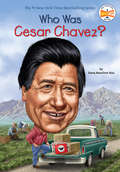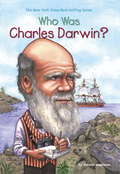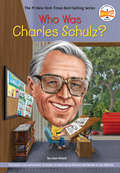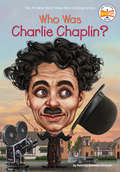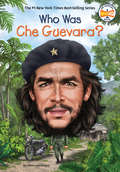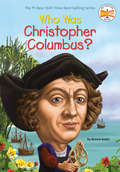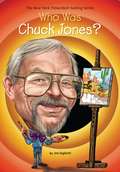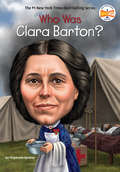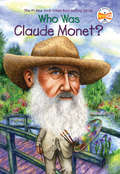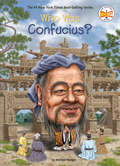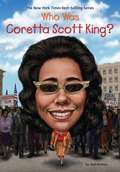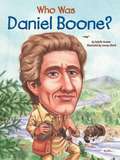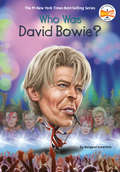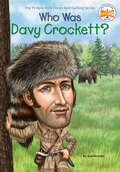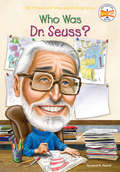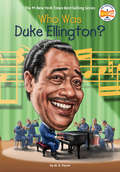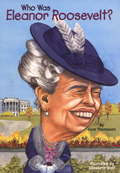- Table View
- List View
Who Was Betty White? (Who HQ Now)
by Dana Meachen Rau Who HQLearn about the remarkable life of actress and comedian Betty White, a pioneer of early television with a seven-decade career, in this title in the Who HQ Now series featuring newsmakers and trending topics.From 1939 to 2021, actress Betty White was one of the most beloved performers in the entertainment industry. She starred in fan-favorite television shows like The Golden Girls and The Mary Tyler Moore Show, and also blockbuster movies like Toy Story 4 and The Proposal. Over her decades-long career, Betty White won Emmy awards, was named an honorary mayor of Hollywood, earned a star on the Walk of Fame, and set the Guinness World Record for woman with the longest TV career ever. Off-screen, Betty advocated for animal rights, racial justice, and LGBTQIA+ rights. Learn about her legendary life in this book for young readers.
Who Was Blackbeard? (Who was?)
by Nancy Harrison James BuckleyThough much of his early life remains a mystery, Blackbeard most likely began his life as Edward Teach in the sailing port of Bristol, England. He began his career as a hired British sailor during Queen Anne's War. He eventually settled in the Bahamas under Captain Benjamin Hornigold who taught the young sailor to go "a-pirating." Soon enough, Blackbeard was commanding his own fleet and stealing ships around the Caribbean and up and down the Eastern seaboard. Known for his thick, black beard and fearsome reputation, the legend of Blackbeard has influenced pirate legend and lore for over 300 years.
Who Was Bob Marley? (Who was?)
by Gregory Copeland Katie EllisonGet Up, Stand Up! for the king of reggae music!Bob Marley was a reggae superstar who is considered to be one of the most influential musicians of all time. Born in rural Jamaica, this musician and songwriter began his career with his band, The Wailing Wailers, in 1963. The Wailers went on to spread the gospel of reggae music around the globe. Bob's distinctive style and dedication to his Rastafari beliefs became a rallying cry for the poor and disenfranchised the world over and led to a hugely successful solo career. After his death in 1981, Bob Marley became a symbol of Jamaican culture and identity. His greatest-hits album, Legend, remains the best-selling reggae album of all time. Who Was Bob Marley? tells the story of how a man with humble roots became an international icon.This title in the New York Times best-selling series contains eighty illustrations that help bring the story to life.
Who Was Booker T. Washington? (Who was?)
by James Buckley Who Hq Jake MurrayLearn how a slave became one of the leading influential African American intellectuals of the late 19th century.African American educator, author, speaker, and advisor to presidents of the United States, Booker Taliaferro Washington was the leading voice of former slaves and their descendants during the late 1800s. As part of the last generation of leaders born into slavery, Booker believed that blacks could better progress in society through education and entrepreneurship, rather than trying to directly challenge the Jim Crow segregation. After hearing the Emancipation Proclamation and realizing he was free, young Booker decided to make learning his life. He taught himself to read and write, pursued a formal education, and went on to found the Tuskegee Institute--a black school in Alabama--with the goal of building the community's economic strength and pride. The institute still exists and is home to famous alumnae like scientist George Washington Carver.
Who Was Bruce Lee? (Who was?)
by Nancy Harrison John Hinderliter Jim GigliottiBruce Lee was a Chinese American action film star, martial arts instructor, filmmaker, and philosopher. His Hong Kong and Hollywood-produced films elevated the traditional martial arts film to a new level of popularity and acclaim. Through such films as Way of the Dragon and Enter the Dragon, Lee helped to change the way Asians were presented in American films and, in the process, he became an iconic figure known throughout the world. Although he died at the young age of 32, Bruce Lee is widely considered to be the one of the most influential martial artists of all time.
Who Was Catherine the Great? (Who Was?)
by Pam Pollack Meg Belviso Who HQLearn how a Prussian princess grew up to be Russia's longest-ruling female leader!Born in 1729, Princess Sophie of Anhalt-Zerbs was never supposed to come to power. But at age sixteen, she married the heir to the Russian throne. By 1762, Sophie, known now as Catherine, overthrew her immature and incompetent husband, Peter III, to lead the nation. Catherine became the sole ruler of Russia. This exciting Who Was? title explores how Catherine was able to turn Russia into one of the great powers of Europe by expanding its borders, helping improve its educational system, and advocating for the arts. Her three-decade reign is considered the Golden Age of Russia, and she is called Catherine the Great.
Who Was Celia Cruz? (Who Was?)
by Pam Pollack Meg Belviso Who HQHow did a working-class girl from Cuba become a symbol of artistic freedom for Cuban Americans and the "Queen of Salsa"? Find out in this addition to the Who HQ library!Although her family and friends know her as Úrsula Hilaria Celia de la Caridad Cruz Alfonso, the world refers to her simply as Celia Cruz. Starting her career in 1950, Celia grew increasingly popular as the new lead singer of the Cuban band Sonora Matancera. Her exceptional vocal range and flashy costumes made fans fall in love with her. Celia's talent took her all around the world, including the United States. After Fidel Castro came to power in Cuba, she wasn't allowed to return to her native country. She and other Cubans who were exiled used their music to express their love for their homeland. Celia rose to the top of the charts in a genre that was dominated by men. She become an award-winning singer and the most popular Latin artist of the twentieth century. Azucar! indeed!
Who Was Cesar Chavez? (Who was?)
by Nancy Harrison Ted Hammond Dana M. RauLearn more about Cesar Chavez, the famous Latino American civil rights activist.When he was young, Cesar and his Mexican American family toiled in the fields as migrant farm workers. He knew all too well the hardships farm workers faced. His public-relations approach to unionism and aggressive but nonviolent tactics made the farm workers' struggle a moral cause with nationwide support. Along with Dolores Huerta, he cofounded the National Farmworkers Association. His dedication to his work earned him numerous friends and supporters, including Robert Kennedy and Jesse Jackson.
Who Was Charles Darwin? (Who was?)
by Deborah Hopkinson Nancy HarrisonAs a young boy, Charles Darwin hated school and was often scolded for conducting "useless" experiments. Yet his passion for the natural world was so strong that he suffered through terrible seasickness during his five-year voyage aboard The Beagle. Darwin collected new creatures from the coasts of Africa, South America, and the Galapagos Islands, and expanded his groundbreaking ideas that would change people's understanding of the natural world.
Who Was Charles Dickens? (Who was?)
by Meg Belviso Nancy Harrison Mark Edward Geyer Pamela D. PollackAs a child, Charles Dickens worked in a shoe polish factory where his gritty surroundings inspired some of the most memorable characters and settings in literary history. Known for his masterful storytelling in books like Oliver Twist, Great Expectations, and A Christmas Carol, Dickens toured the globe as one of the most famous people of his era. Widely considered the greatest writer of the Victorian age, Dickens's literary masterpieces continue to amuse and inspire writers and readers alike.
Who Was Charles Schulz? (Who Was?)
by Joan Holub Who HQLearn more about the cartoonist who created Charlie Brown, Snoopy, and the rest of the lovable Peanuts gang in this new addition to the #1 New York Times bestselling series!Charles (otherwise known as Sparky) Schulz always loved drawing from the time he was a young child, and as he grew older, he turned this passion into a phenomenally successful career. His early doodles of his mischievous dog and of a shy boy inspired two of his most familiar and beloved characters, Charlie Brown and Snoopy. Here's the story about Peanuts gang and Charles's life that's sure to excite all readers but especially those who love the classic cartoon series.
Who Was Charlie Chaplin? (Who was?)
by Patricia Brennan DemuthWho was the real Charlie Chaplin? Kids will learn all about the comic genius who created "The Little Tramp"!Charlie Chaplin sang on a London stage for the first time at the age of five. Performing proved to be his salvation, providing a way out of a life of hardship and poverty. Success came early and made Chaplin one of the best loved people in the United States until the McCarthy witch hunts drove Chaplin from his adopted country. This is a moving portrait of a multi-talented man--actor, director, writer, even music composer--and the complicated times he lived in.
Who Was Che Guevara? (Who Was?)
by Ellen Labrecque Who HQViva la revolución! Find out how Che Guevara--a doctor turned communist leader and much more than a face on a T-shirt--ended up paying the ultimate price for his cause. His very image has become associated with a spirit of rebellion, but Ernesto Guevara--known around the world simply as Che--didn't dream of becoming a revolutionary. Author Ellen Labrecque takes readers on a journey through Che's life starting with his childhood in Argentina, to his travels through South and Central America as a young physician, and ending with his final years as a key player in the Cuban revolution. His legacy--as the author of The Motorcycle Diaries, a champion of the poor, and a force for change in Cuba--is both personal and political.
Who Was Christopher Columbus? (Who was?)
by Nancy Harrison Bonnie BaderLearn all about Christopher Columbus' early life at sea, which led him to seek fortune by sailing west in hopes of creating new trade routes with the Indies. Kids will read about why he called himself the "Great Admirald of the Seas" and learn of all his struggles to find finacial support for his voyage.
Who Was Chuck Jones? (Who was?)
by John Hinderliter Jim Gigliotti Who Hq"What's Up, Doc?" Find out in this lively biography of the most celebrated director in animation history!Charles Martin "Chuck" Jones was an American animator, cartoon artist, screenwriter, producer, and director of many classic animated cartoon shorts. They starred Bugs Bunny, Daffy Duck, the Road Runner and Wile E. Coyote, Pepé Le Pew, Porky Pig and a slew of other Warner Brothers characters. When he moved on to Metro-Goldwyn-Mayer, his work includes a series of Tom and Jerry shorts as well as the television adaptation of Dr. Seuss's How the Grinch Stole Christmas. Jones was nominated for eight Academy Awards, won three, and received an honorary Oscar for his work in the animation industry. His career spanned almost seventy years, during which he made over 250 animated films, including What's Opera, Doc?, a classic Bugs Bunny/Elmer Fudd short that is considered to be one of the greatest cartoons of all time.
Who Was Clara Barton? (Who Was?)
by Who HQ Stephanie SpinnerClarissa “Clara” Barton was a shy girl who grew up to become a teacher, nurse, and humanitarian. At a time when few women worked outside the home, she became the first woman to hold a government job, as a patent clerk in Washington, DC. In 1864, she was appointed “lady in charge” of the hospitals at the front lines of the Union Army, where she became known as the “Angel of the Battlefield.” Clara Barton built a career helping others. She went on to found the American Red Cross, one of her greatest accomplishments, and one of the most recognized organizations in the world.
Who Was Claude Monet? (Who was?)
by Nancy Harrison Ann Waldron Stephen MarchesiClaude Monet is considered one of the most influential artists of all time. He is a founder of the French Impressionist art movement, and today his paintings sell for millions of dollars. <P><P>While Monet was alive, however, his work was often criticized and he struggled financially. With over one hundred black-and-white illustrations, this book unveils a true portrait of the artist!
Who Was Confucius? (Who Was?)
by Michael Burgan Who HQLearn more about China's most famous teacher and philosopher, whose ideas are still influential today.Born in 551 BC, Confucius was a young man when he set his heart and mind on learning as much as he could. By his thirties, he'd become a brilliant teacher who shared his knowledge of several subjects, including arithmetic, history, and poetry, with his students. Confucius wanted to make sure that everyone in China had access to an education and devoted his whole life to learning and teaching so he could transform and improve society. His lessons--now known as Confucianism--are practiced by over six million people in the world. They focus on loving humanity, worshiping ancestors, respecting elders, and self-discipline. Confucianism has become the system that governs a total way of life in East Asia.
Who Was Coretta Scott King? (Who was?)
by Gail Herman Gregory Copeland Who HqThe wife of Martin Luther King Jr., Coretta Scott King was a civil rights leader in her own right, playing a prominent role in the African American struggle for racial equality in the 1960s.Here's a gripping portrait of a smart, remarkable woman. Growing up in Alabama, Coretta Scott King graduated valedictorian from her high school before becoming one of the first African American students at Antioch College in Ohio. It was there that she became politically active, joining the local chapter of the National Association for the Advancement of Colored People (NAACP). After her marriage to Martin Luther King Jr., Coretta took part in the Civil Rights Movement. Following her husband's assassination in 1968, she assumed leadership of the movement. Later in life she was an advocate for the Women's Rights Movement, LGBT rights, and she worked to end apartheid in South Africa.
Who Was Daniel Boone? (Who was?)
by Sydelle KramerCalled the "Great Pathfinder", Daniel Boone is most famous for opening up the West to settlers through Kentucky. A symbol of America's pioneering spirit Boone was a skilled outdoorsman and an avid reader although he never attended school. <P><P>Sydelle Kramer skillfully recounts Boone's many adventures such as the day he rescued his own daughter from kidnappers.
Who Was David Bowie? (Who Was?)
by Margaret Gurevich Who HQFind out how this English singer-songwriter and actor who constantly reinvented his look and sound became one of the most influential musicians of the twentieth century in this new book from the #1 New York Times bestselling series.David Bowie, born David Robert Jones, wasn't just an incredible singer; he had an amazing talent for keeping his fans happily guessing about what he would do next. He alternated between musical genres with ease, established a successful acting career, and even created a legendary persona--the rocker alien Ziggy Stardust--that people still dress up as for Halloween each year. Author Margaret Gurevich takes readers through David Bowie's life and shows exactly why he is an inspiration to many people and is celebrated all over the world.
Who Was Davy Crockett? (Who was?)
by Gail Herman Nancy Harrison Robert SquierDavy Crockett, the King of the Wild Frontier, is a man of legend. He is said to have killed his first bear when he was three years old. His smile alone killed another, and he skinned a bear by forcing him to run between two trees. Fact or fiction? Find out the real story of this folk hero, who did love to hunt bears, served as a congressman for Tennessee, and fought and died at the Alamo.
Who Was Dr. Seuss? (Who Was?)
by Nancy Pascal Janet HarrisonTed Geisel loved to doodle from the time he was a kid. He had an offbeat, fun-loving personality. He often threw dinner parties where guests wore outrageous hats! And he donned quirky hats when thinking up ideas for books-?like his classic The Cat in the Hat. This biography, with black-and-white illustrations throughout, brings an amazingly gifted author/illustrator to life. .
Who Was Duke Ellington? (Who Was?)
by Who HQ M. D. PayneHow did a working-class young man from Washington, DC, turn the music world on its head and become the "Master Of Jazz"? Find out in this addition to the Who HQ library!A pivotal fixture of the Harlem Renaissance, Duke Ellington was the bandleader of the historic Cotton Club and a master composer -- writing close to 3,000 songs in his lifetime and capturing the spirit of the Black experience in the Unites States. Over a 50-year career, Ellington became one of the biggest names in jazz as we know it. He went on to win 13 Grammys, a Pulitzer, and receive the Presidential Medal of Freedom in 1969. Who Was Duke Ellington? follows the exciting, multifaceted journey of this musical genius and takes a look at what truly makes Ellington an artist "beyond category."
Who Was Eleanor Roosevelt? (Who was?)
by Gare Thompson Nancy HarrisonFor a long time, the main role of First Ladies was to act as hostesses of the White House...until Eleanor Roosevelt. Born in 1884, Eleanor was not satisfied to just be a glorified hostess for her husband, President Franklin Delano Roosevelt. Eleanor had a voice, and she used it to speak up against poverty and racism. She had experience and knowledge of many issues, and fought for laws to help the less fortunate. She had passion, energy, and a way of speaking that made people listen, and she used these gifts to campaign for her husband and get him elected president-four times! A fascinating historical figure in her own right, Eleanor Roosevelt changed the role of First Lady forever.
